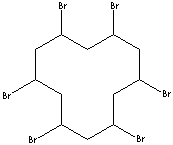PRODUCT IDENTIFICATION

221-695-9
H.S. CODE
2903.59.7000
TOXICITY
C1C(C(CCC(C(CCC(C(C1)Br)Br)Br)Br)Br)Br
CLASSIFICATION
Flame retardant
PHYSICAL AND CHEMICAL PROPERTIES
MELTING POINT
SOLUBILITY IN WATER
NFPA RATINGS
REFRACTIVE INDEX
GENERAL DESCRIPTION & EXTERNAL LINKS
Hexabromocyclododecane is used as a flame retardant for expandable polystyrene, polyurethane, plastics, paper and textiles. Fire extinguishing media. It can be combined with synergist such as antimony trioxide for maximum flame retardant performance.
.....Tetrabromobisphenol A (TBBPA) and hexabromocyclododecane (HBCD) are two brominated chemicals that are used as flame retardant materials in a variety of products. These flame retardants have desirable properties, and have proven to be successful flame retardant materials during years of use for a variety of applications. For example, HBCD combines high effectiveness with very low loading levels which enable polystyrene insulation products used in the building industry to meet required flame retardancy standards, while maintaining their insulation properties...... (http://sustainableproduction.org/)
APPEARANCE
BROMINE CONTENT
73.0% min
MELTING POINT
LOSS ON DRYING
0.5% max
6.1 (Packing group : III)
Flame Retardants are substances that can be chemically inserted into the polymer molecule or be physically blended in polymers after polymerization to suppress, reduce, delay or modify the propagation of a flame through a plastic materials. There are several classes of flame retardants; Halogenated Hydrocarbons (Chlorine and Bromine containing compounds and reactive flame retardants), Inorganic flame retardants ( Boron compounds, Antimony oxides, Aluminium Hydroxide, molybdenum compounds, zinc and magnesium oxides ), Phosphorous containing compounds (Organic phosphate esters, phosphates, halogenated phosphorus compounds and inorganic phosphorus containing salts).
Class of Flame Retardants
- Inorganic
- Metal hydroxides
- Aluminium hydroxide
- Magnesium hydroxide
- Orthers
- Antimony compounds
- Antimony trioxide
- antimony pentoxide
- Sodium antimonate
- Others
- Boron compounds
- Boric acid
- Borax
- Zinc borate
- Others
- Other metal compounds
- Molybdenum compounds
- Titanium compounds
- Zirconium compounds
- Zinc compounds
- Zinc stannate
- Zinc hydroxy-stannate
- Others
- Others
- Phosphorus compounds
- Red phosphorus
- Ammonium polyphosphate
- Others
- Other inorganic flame retardants
- ammonium sulfamate
- ammonium bromide
- Others
- Halogenated organic
- Brominated
- Tetrabromobisphenol A
- Decabromodiphenyl ether
- Octabromobiphenyl ether
- Tetrabromobiphenyl ether
- Hexabromocyclododecane
- Tribromophenol
- Bis(tribromophenoxy) ethane
- Tetrabromobisphenol A polycarbonate oligomers
- Tetrabromobisphenol A epoxy oligomers
- Others
- Chlorinated
- Chlorinated paraffins
- Bis(hexachlorocyclopentadieno)cyclo-octane
- Others
- Organophosphoros
- Non-halogenated compounds
- phosphate esters
- Ttrialkyl phosphates
- Triaryl phosphates
- Aryl-alkyl phosphates
- Others
- polyols
- phosphonium derivatives
- phosphonates
- Others
- Halogenated phosphates
- Tris(1-chloro- 2-propyl) phosphate
- Tris(2-chloroethyl) phosphate
- Tris(2,3-dibromopropyl)phosphate
- Others
- Nitrogen-based
- Polyurethanes
- Polyamides
- Melamine and its salts
- Guanidine compounds
- Others